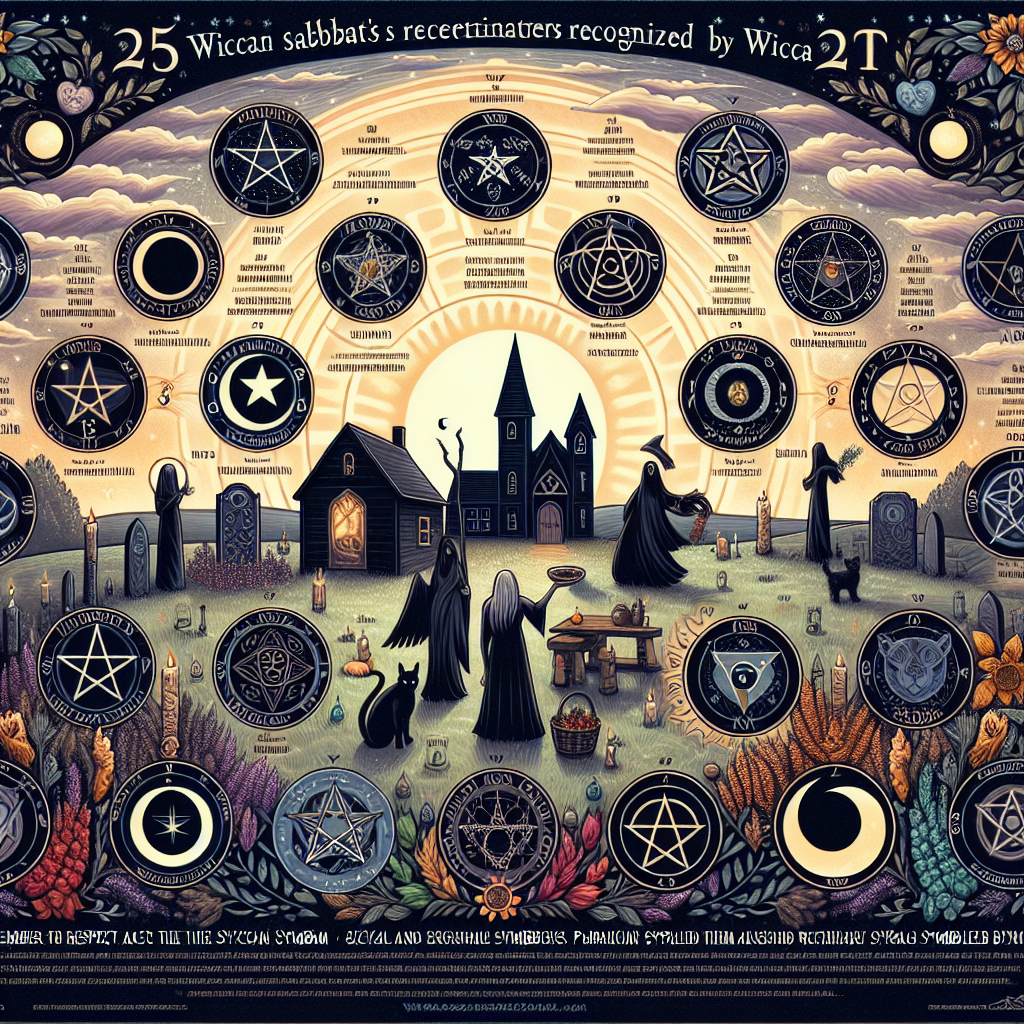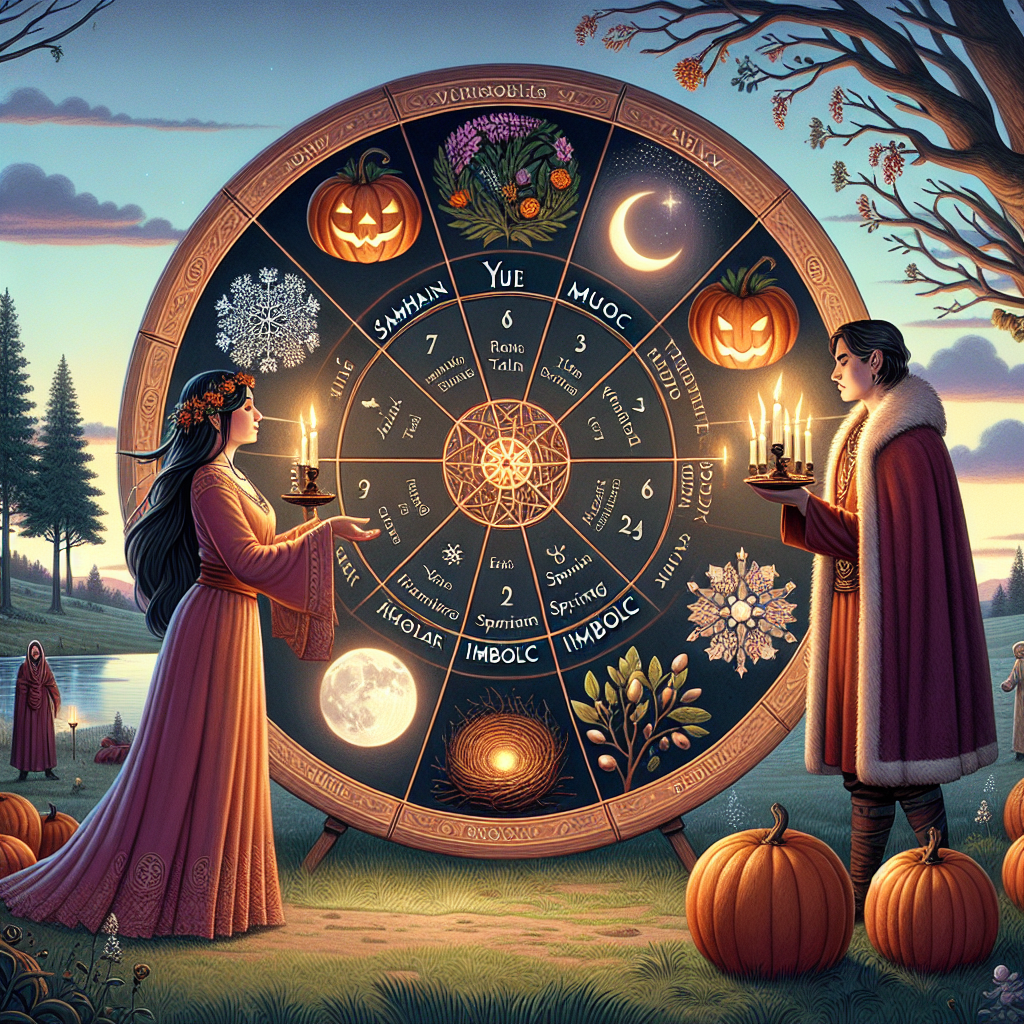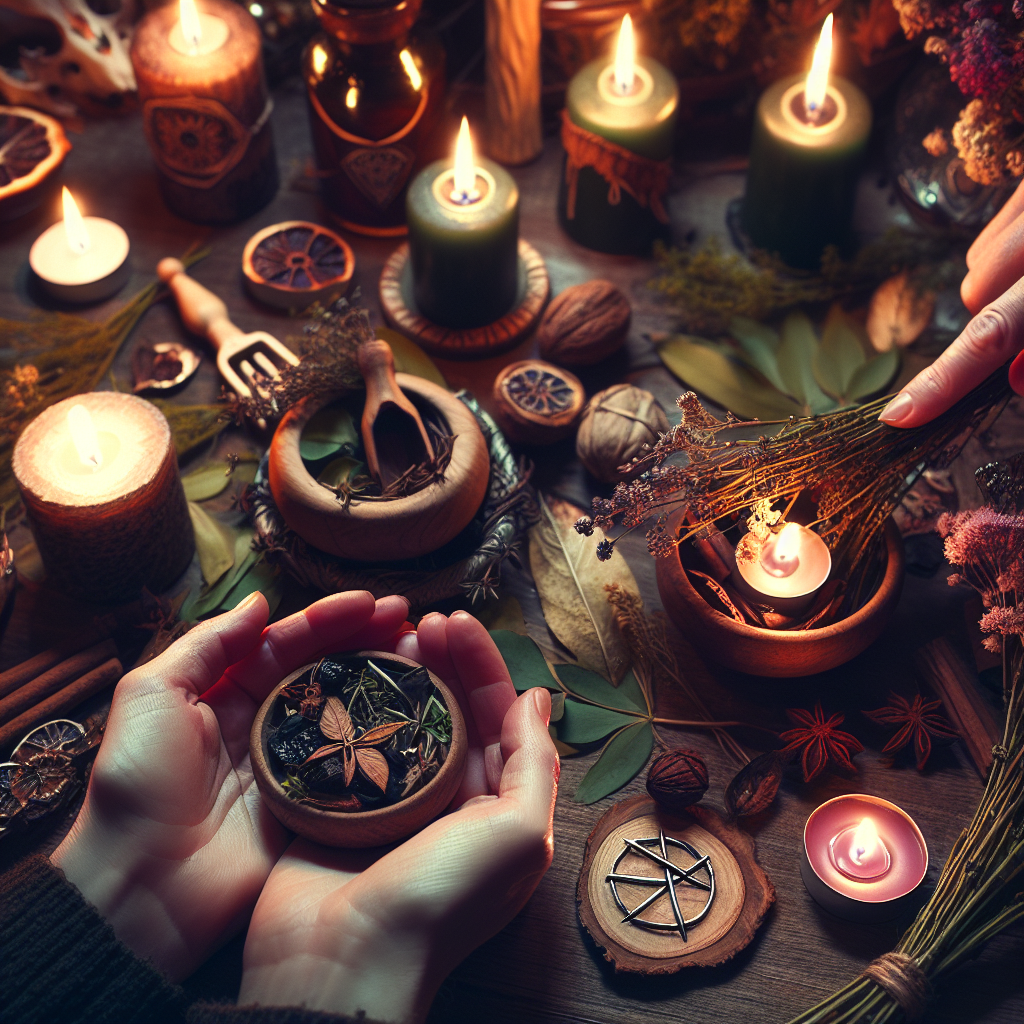As an Amazon Associate I earn from qualifying purchases.

An Overview of the 25 Must-Know Wiccan Sabbats
Wiccan Sabbats are a series of eight festivals that celebrate the changing seasons and honor the cycle of the Wheel of the Year. These Sabbats are crucial for Wiccan practitioners as they are integral to the faith’s celebration of nature and the divine. Originating from ancient Celtic and other pagan traditions, these Sabbats have been adapted into modern Wicca since its formalization in the mid-20th century by Gerald Gardner. Today, they hold immense significance for practitioners around the globe, especially as they offer a structured way to mark time and express spirituality through ceremonies and rituals. A growing number of people, estimating around one to three million global practitioners, observe these Sabbats, highlighting their importance in contemporary spirituality.
The Eight Key Sabbats
Samhain, observed on October 31st, marks the end of the harvest season and is seen as a time when the veil between the living and the dead is thinnest. Yule, celebrated around December 21st during the Winter Solstice, honors the rebirth of the sun and long-held customs like lighting a Yule log. Imbolc, on February 1st-2nd, signifies the awakening of the earth and the beginning of spring, often celebrated with candles and fires.
Ostara, aligning with the Spring Equinox around March 21st, symbolizes balance and the renewal of life, a time for planting seeds and celebrating fertility. Beltane, on May 1st, is one of the most vibrant Sabbats, dedicated to fertility, passion, and growth, celebrated with maypole dances and bonfires. Litha, observed around June 21st during the Summer Solstice, marks the height of the sun’s power and the abundance of light, often featuring feasts and outdoor activities.
Lammas or Lughnasadh, on August 1st, recognizes the first harvest and is a time for giving thanks for abundance, commonly celebrated with bread-making and feasts. Mabon, coinciding with the Autumn Equinox around September 21st, is a time of balance and gratitude, marking the second harvest and preparing for the darker days ahead with community feasts and offerings of the season’s bounty.
Understanding the Lesser-Known Sabbats
Each of these eight Sabbats holds unique significance and customs, which can vary slightly among Wiccan traditions but share a common theme of honoring the earth and its cycles. However, Wiccan practice also acknowledges intermediate or lesser-known Sabbats that are equally important for understanding the full breadth of the tradition.
The esbats, occurring monthly during the Full Moon, provide an additional time for magical workings and spiritual reflection, offering a more frequent opportunity to connect with the divine. The Solstices and Equinoxes themselves serve as vital markers for the changing seasons, which Wiccans celebrate with specific rituals and offerings, reinforcing a deep connection to the natural world and its rhythms. These festivals, together with the eight major Sabbats, form a comprehensive framework for spiritual practice throughout the year.
The Wiccan Sabbats are integral to practicing Wicca, serving as both spiritual markers and gateways to deeper relationships with the natural world. Celebrated throughout the year, these witchcraft holidays are pivotal for practitioners. Here are 25 Must-Know Wiccan Sabbats every practitioner should be familiar with:
1. **Samhain (October 31st – November 1st)**: Known as the Wiccan New Year, Samhain is dedicated to honoring the ancestors and deceased. This festival is a time when the veil between the worlds is thinnest, making communication with spirits easier.
2. **Yule (Winter Solstice, around December 21st)**: Yule celebrates the rebirth of the Sun God. Seasonal rituals include lighting candles and yule logs to bring light into the darkest days of the year.
3. **Imbolc (February 1st – 2nd)**: Imbolc marks the halfway point between winter and spring. This Sabbat is dedicated to Brigid, the goddess of fertility and healing, and focuses on purification and setting intentions for the year ahead.
4. **Ostara (Spring Equinox, around March 21st)**: Celebrated when day and night are equal, Ostara is a festival of balance and new beginnings. It is a time for planting seeds and celebrating fertility.
5. **Beltane (April 30th – May 1st)**: Beltane is a fire festival celebrating fertility, love, and the blossoming of life. Wicca festivals often include jumping over bonfires and dancing around Maypoles.
6. **Litha (Summer Solstice, around June 21st)**: Known as Midsummer, Litha marks the longest day of the year. This Sabbat celebrates abundance, strength, and the power of the Sun.
7. **Lammas or Lughnasadh (August 1st)**: This first harvest festival honors the Celtic god Lugh. Seasonal rituals include baking bread from the first grain harvest and giving thanks for abundance.
8. **Mabon (Autumn Equinox, around September 21st)**: Mabon is another time of balance and thanksgiving. This Wiccan Sabbat celebrates the second harvest and encourages practitioners to give thanks for the Earth’s bounty.
9. **Esbats**: While not a Sabbat, Esbats are monthly rites aligned with the phases of the Moon. They are times for spellwork, divination, and connecting with lunar energies.
10. **Alban Eilir (Druid festival coinciding with Ostara)**: This focuses on renewal and new life.
11. **Alban Arthan (Druid festival overlapping with Yule)**: Celebrated as a time of rebirth.
12. **Alban Hefin (Druid term for Litha)**: Emphasizing the fullness of life.
13. **Alban Elfed (Druid festival coinciding with Mabon)**: Recognizing the balance of light and dark.
14. **Twelfth Night (January 5th-6th)**: The end of Yule celebrations focusing on merry-making and feasting.
15. **Handfastings (Wiccan marriage ceremonies)**: Often performed at Beltane, symbolizing the union of deities.
16. **Croning Ceremonies**: Celebrations for women entering the crone stage of life, often held on Samhain.
17. **Honey Moon**: A June fertility rite focused on sweetness and abundance.
18. **Grovefest or Festival of Trees**: Emphasizing the sacredness of trees, occurring during Beltane or Litha.
19. **Harvest Home**: Similar to Mabon, focused solely on the harvest’s return.
20. **Requiem Rites**: Can be performed during Samhain to honor deceased animals.
21. **Shining Flame**: Celebrated during Imbolc, focusing on personal purification through fire.
22. **Equinox Fires**: Both Ostara and Mabon fire rituals to maintain balance.
23. **Lammas Day Feasts**: Large community gatherings to celebrate food’s abundance.
24. **Family Blessing**: Performed during Yule or Mabon, focusing on family unity.
25. **Candle Blessing**: Typically held at Imbolc, involving the blessing of candles used throughout the year.
According to the American Religious Identification Survey (ARIS) conducted in 2008, the number of self-identified Wiccans in the United States increased dramatically from about 8,000 in 1990 to 342,000 in 2008.
Yule
The Yule celebration in my household has always been a time of reflection and renewal. We make it a point to wake up early to greet the sunrise, marking the return of longer days. My partner and I usually spend hours preparing a feast that includes traditional foods like roasted root vegetables and hearty stews.
One memorable Yule, we had a huge snowstorm that left us temporarily snowed in. Instead of feeling trapped, it turned into a magical day of deep connection with nature. We spent the afternoon making bird feeders out of pinecones, peanut butter, and bird seed, hanging them around the yard for any wildlife brave enough to venture out.
In the evening, we conducted a simple Yule ritual. Lighting candles around an evergreen wreath, we set intentions for the coming year. The quiet and stillness outside seemed to amplify the energy of our prayers and meditations. This Yule reinforced for me the importance of embracing both the hardships and joys of winter.
Imbolc
Every Imbolc, I feel a palpable excitement as the first signs of spring begin to show. My tradition involves a thorough cleansing of my home, and this activity is always invigorating. Last Imbolc, I spent an entire day decluttering and smudging every room, accompanied by soothing chants.
One significant aspect of my Imbolc celebrations is the creation of a Brigid’s Cross. My children and I gather rushes or reeds from nearby streams to craft these symbols of protection and health. It’s a fun activity that also serves an educational purpose, teaching them about the significance of Imbolc and the goddess Brigid.
The ritual I perform for Imbolc tends to be simple but deeply meaningful. I light white candles and place them on my altar, dedicated to Brigid. During this ritual, I often focus on spiritual renewal and setting goals for the new season. The sense of growing daylight matches my own burgeoning ambition for personal projects.
Beltane
Beltane is undoubtedly one of my favorite Sabbats, filled with vibrant energy and celebration. One year, my friends and I organized a large Beltane festival in a nearby forest. We constructed a Maypole, and everyone took turns dancing around it, weaving brightly colored ribbons in intricate patterns.
Around my personal altar, I place fresh flowers, particularly hawthorn and marigolds, which symbolize the blossoming of new life. The scent of these flowers fills the room, enhancing the overall atmosphere during my Beltane rituals. I also incorporate a small bonfire in my backyard, where we jump over flames for luck and fertility.
Sharing food and drink is an important part of Beltane for me. I usually prepare a large meal that includes seasonal produce like strawberries and cream, and savory pies. It’s a wonderful way to connect with friends and family, invoking the spirit of community and joy that Beltane represents.
Samhain
Samhain is a deeply spiritual time for me, acting as the Wiccan New Year, and offering a profound connection to ancestors. One year, I set up an elaborate altar with photographs, heirlooms, and personal items that belonged to my deceased grandparents. The act of arranging these items felt like a conversation with the past.
I always perform a guided meditation during Samhain to communicate with ancestors and seek their wisdom. On one memorable occasion, I lit black candles and burned incense with a strong earthy scent, which created an atmosphere ripe for deep spiritual connection. The messages I received were comforting and insightful.
Another important activity during Samhain is my annual visit to the local cemetery to pay respects. This ritual involves cleaning and adorning gravesites with marigolds and candles. It serves as a powerful reminder of life’s cyclical nature and the continual spiritual connections we maintain with those who have passed on.
u003ch2u003e1. What are Wiccan Sabbats?u003c/h2u003e
u003cpu003eWiccan Sabbats are a series of seasonal festivals observed by Wiccans and modern pagans that are tied to the changing seasons and agricultural cycles. They are major components of the Wheel of the Year.u003c/pu003e
u003ch2u003e2. How many Wiccan Sabbats are there?u003c/h2u003e
u003cpu003eThere are eight Wiccan Sabbats in total, divided into four Greater Sabbats (Samhain, Imbolc, Beltane, and Lammas) and four Lesser Sabbats (Yule, Ostara, Litha, and Mabon).u003c/pu003e
u003ch2u003e3. When do Wiccan Sabbats typically take place?u003c/h2u003e
u003cpu003eWiccan Sabbats are spread throughout the year. They correspond to solstices, equinoxes, and the points in between. For example, Yule occurs around the Winter Solstice, Ostara around the Spring Equinox, Litha around the Summer Solstice, and Mabon around the Autumn Equinox.u003c/pu003e
u003ch2u003e4. What is the significance of Samhain in Wiccan practice?u003c/h2u003e
u003cpu003eSamhain, celebrated on October 31st, is considered one of the most important Sabbats. It marks the end of the harvest and the beginning of winter. It is also believed to be a time when the veil between the living and the dead is thinnest.u003c/pu003e
u003ch2u003e5. Are there specific rituals associated with each Sabbat?u003c/h2u003e
u003cpu003eYes, each Wiccan Sabbat has its own unique rituals and traditions. These can include activities like bonfires, feasting, making offerings to deities, and performing seasonal rites that reflect the themes of life, death, rebirth, and renewal.u003c/pu003e
u003ch2u003e6. Can non-Wiccans celebrate the Sabbats?u003c/h2u003e
u003cpu003eWhile the Sabbats are specific to Wiccan and pagan traditions, anyone interested in earth-based spirituality or seasonal celebrations can take part in them. Respect and understanding of their significance is appreciated.u003c/pu003e
u003ch2u003e7. What should I wear to a Sabbat celebration?u003c/h2u003e
u003cpu003eThere is no strict dress code for Sabbat celebrations, but many practitioners prefer to wear ritual robes, nature-themed clothing, or seasonal colors that align with the specific Sabbat they are celebrating.u003c/pu003e
u003ch2u003e8. How can I start celebrating the Sabbats if I am a beginner?u003c/h2u003e
u003cpu003eIf you are new to Wicca or paganism, start with simple rituals such as lighting candles, making seasonal decorations, cooking traditional foods, or meditating on the themes of each Sabbat. Research and connect with local pagan communities for support.u003c/pu003e
u003ch2u003e9. Is it necessary to have an altar for Sabbat celebrations?u003c/h2u003e
u003cpu003eHaving an altar can enhance your Sabbat celebrations, providing a focal point for your rituals and offerings. It can be as simple or elaborate as you wish, including symbols, candles, and objects relevant to the Sabbat.u003c/pu003e
u003ch2u003e10. Can Sabbats be celebrated alone or do they require a group?u003c/h2u003e
u003cpu003eSabbats can be celebrated both alone and in groups. Solitary practitioners often adapt rituals for solo practice, while groups may gather for more elaborate communal celebrations. Both approaches are valid and effective.u003c/pu003e

## Conclusion
The exploration of the 25 must-know Wiccan Sabbats illuminates the rich tapestry of spiritual practices that punctuate the Wiccan calendar, each imbued with its unique significance and traditional rites. These Sabbats, deeply linked to the seasonal cycles and phases of the Earth, offer practitioners diverse opportunities to connect with nature’s rhythms and honor the divine. From the solar celebrations like Yule and Litha, marking the depths of winter and the height of summer respectively, to the equinox festivities of Ostara and Mabon that epitomize balance and transition, each Sabbat invites meaningful reflection and communion with the natural world. Lesser-known but equally vital are the fire festivals such as Imbolc, Beltane, Lughnasadh, and Samhain, each acting as a sacred point of transformation and renewal within the Wiccan Wheel of the Year.
Engaging in these Sabbats fosters a deeper understanding and appreciation of the cycles of birth, growth, death, and rebirth, cementing their importance in Wiccan practice. Each celebration is marked by distinctive symbols, rituals, and activities that resonate with specific energies of the season, from sowing and reaping to honoring ancestors and the unseen. By participating in these ancient traditions, practitioners strengthen their spiritual foundation, cultivate a sense of community, and maintain a harmonious connection with the Earth. In essence, the Wiccan Sabbats are not merely ritualistic observances but transformative experiences that enrich the practitioner’s path, fostering a profound alignment with the natural and mystical forces that govern our existence.
Amazon and the Amazon logo are trademarks of Amazon.com, Inc, or its affiliates.


